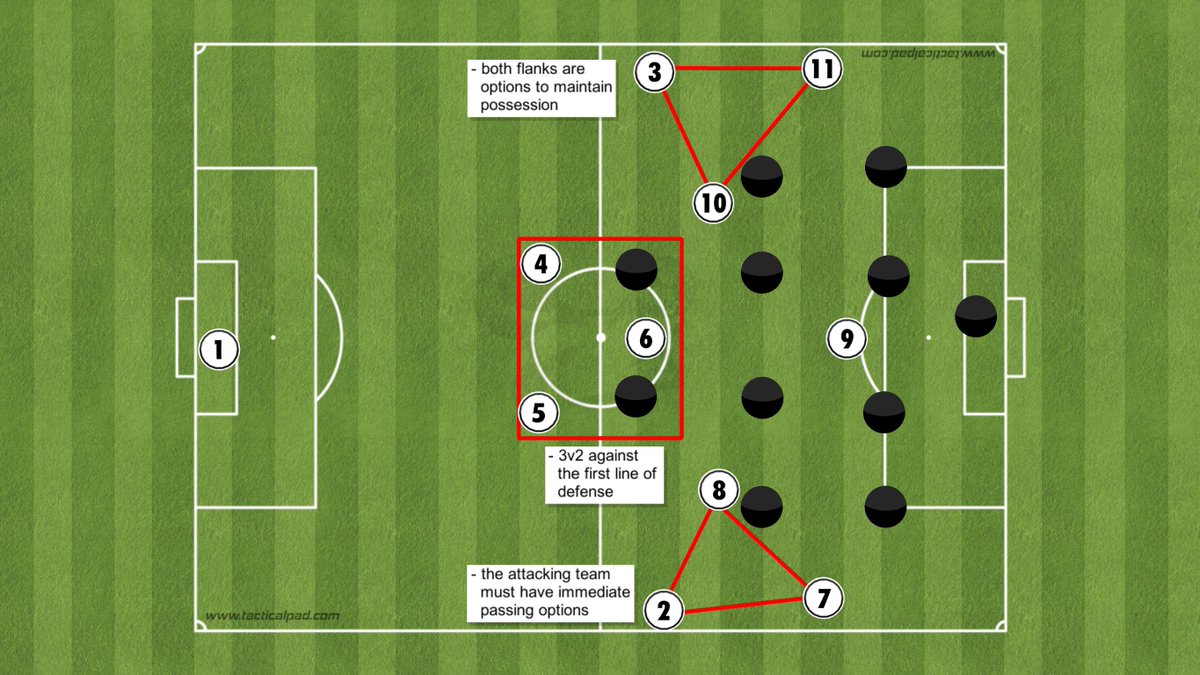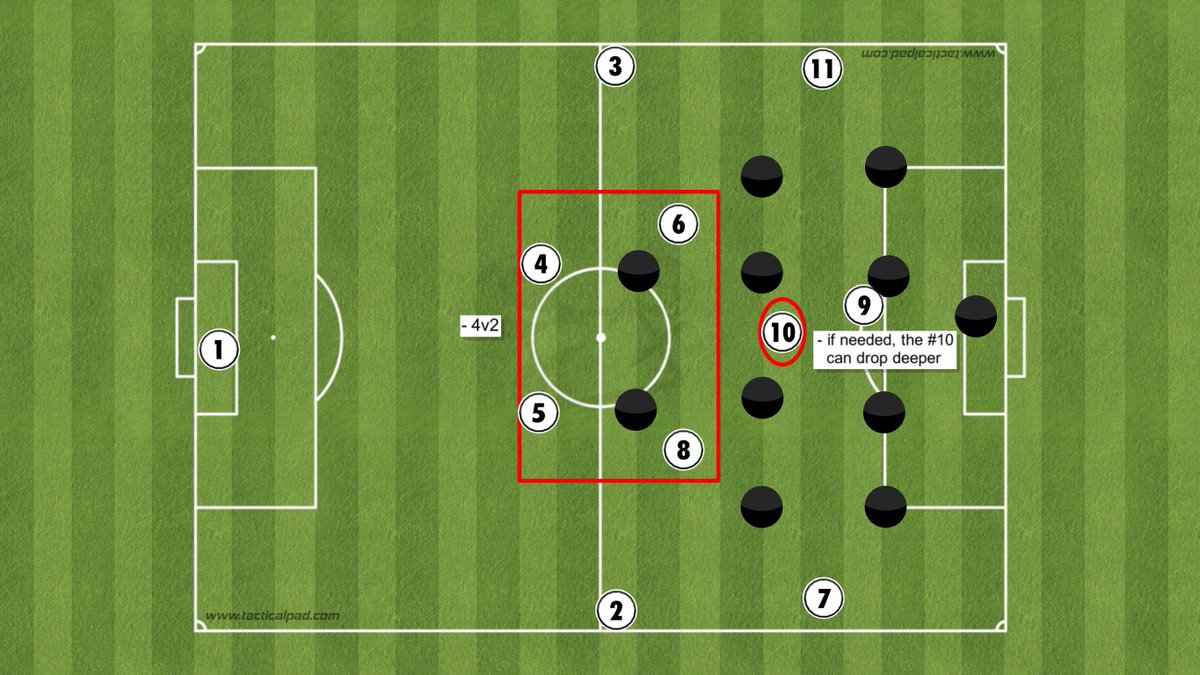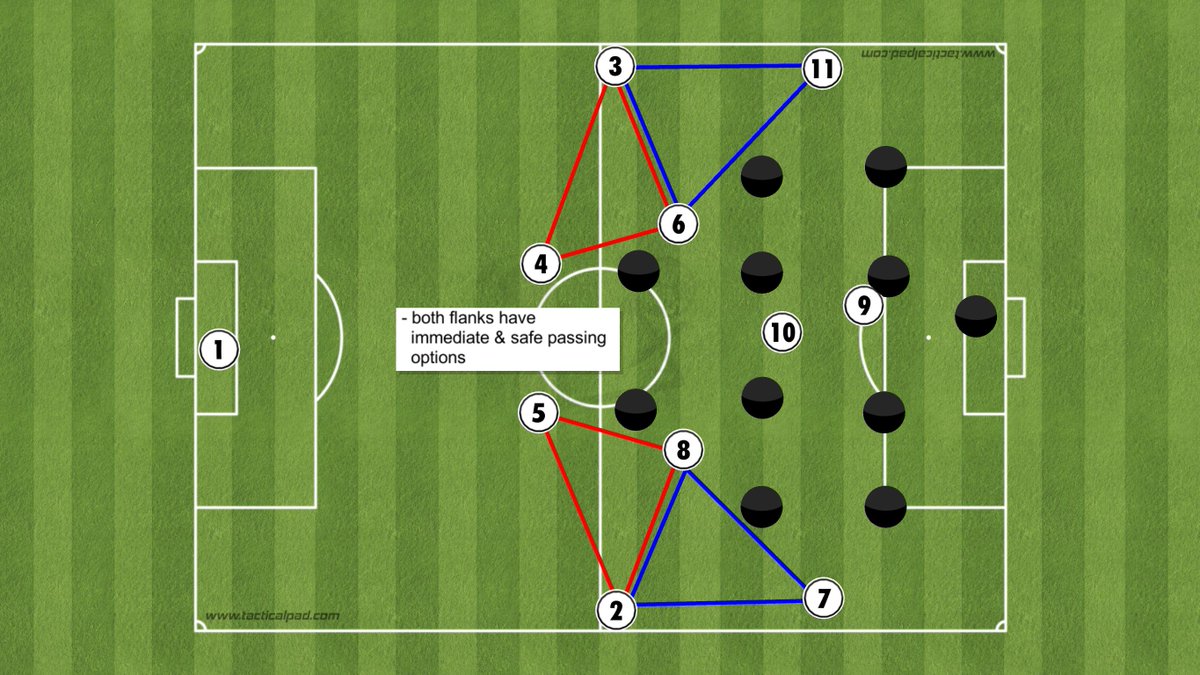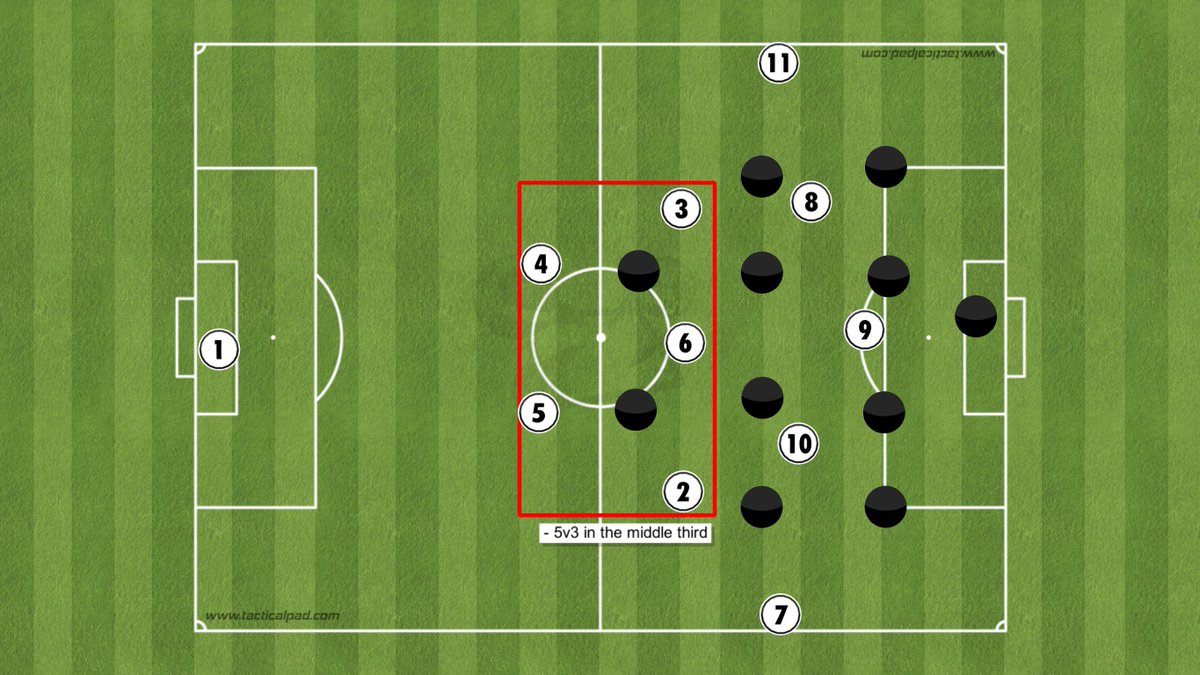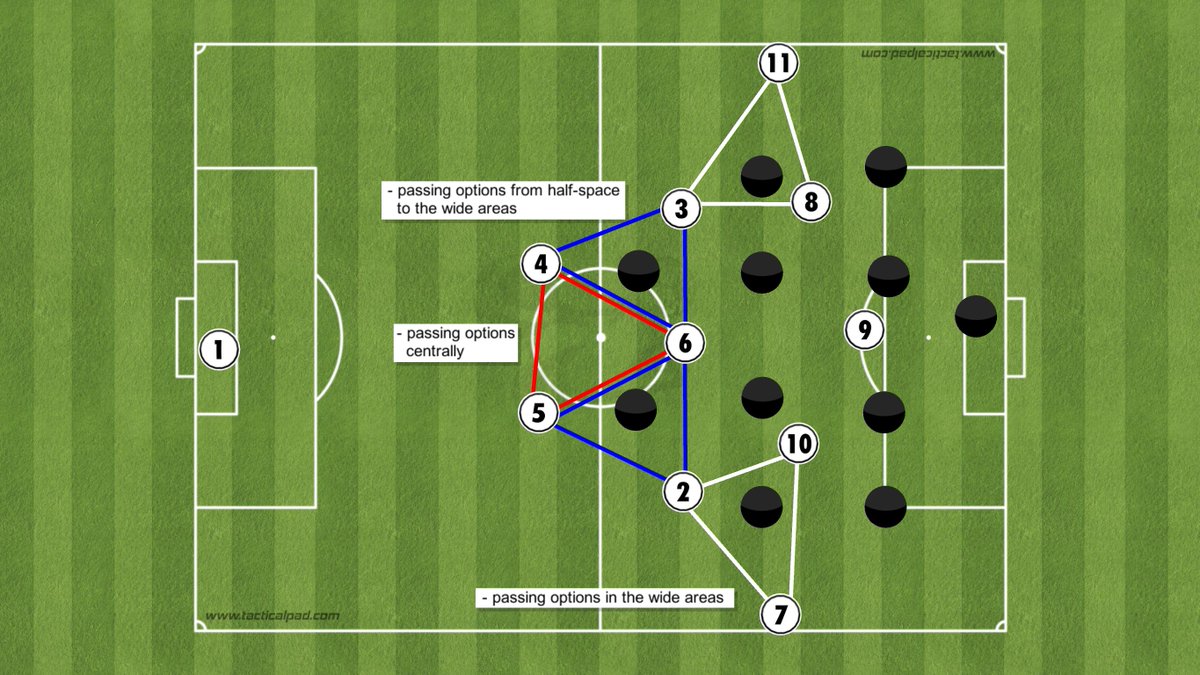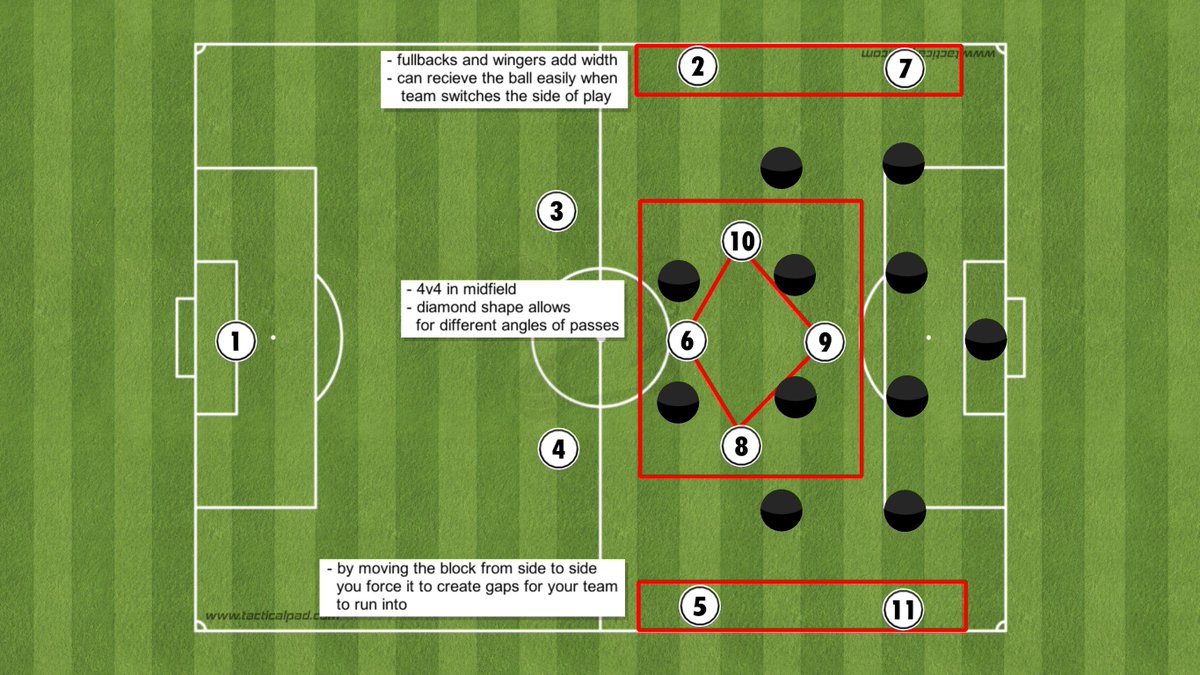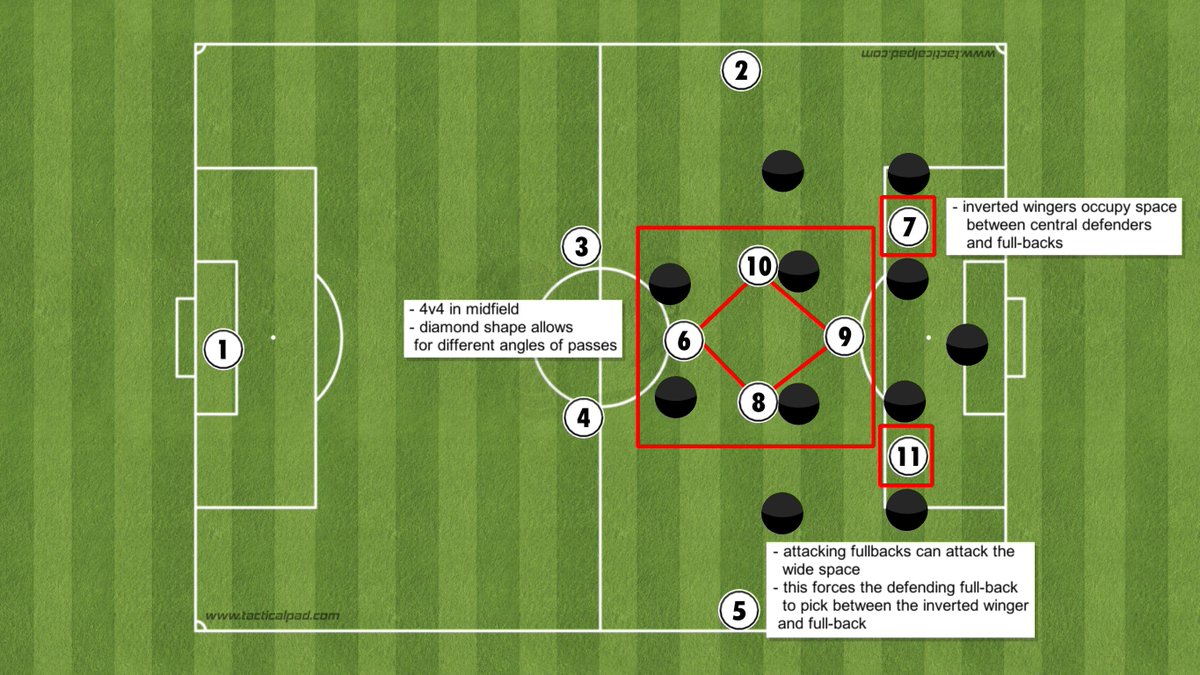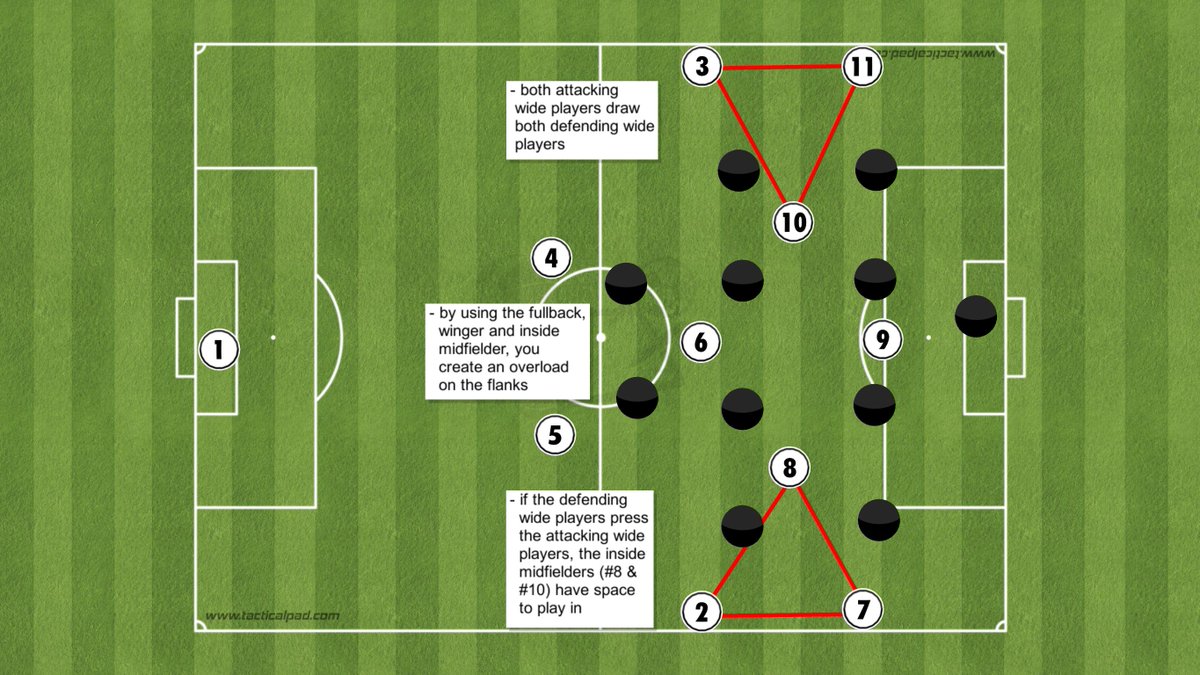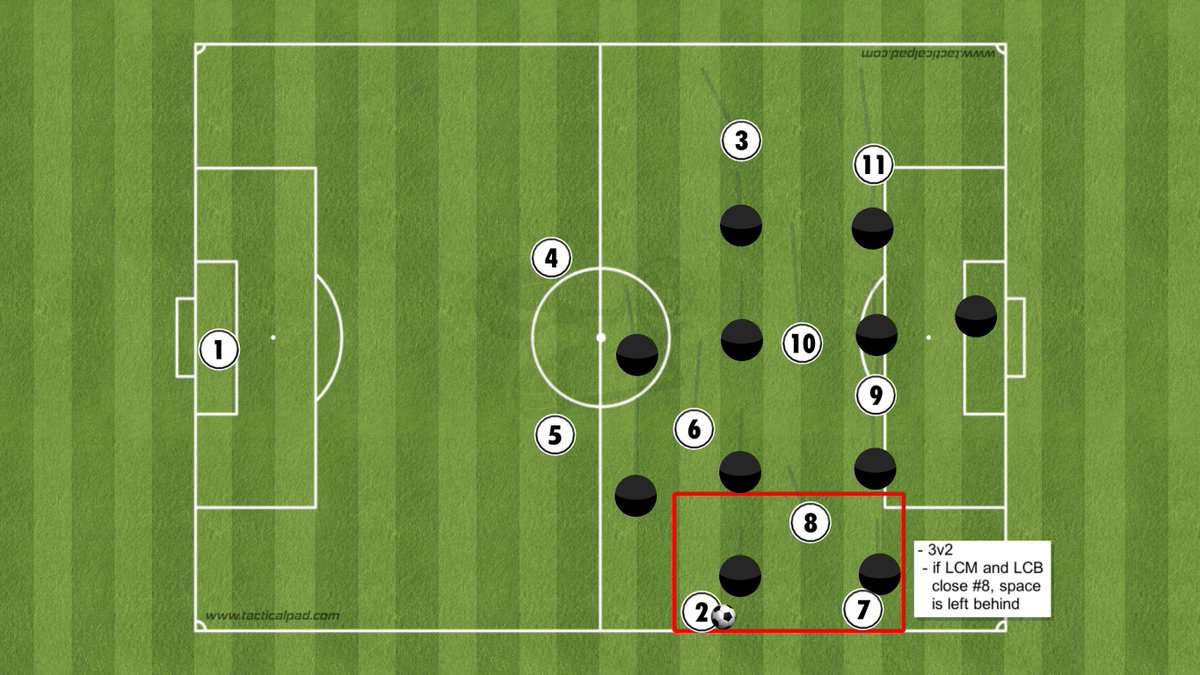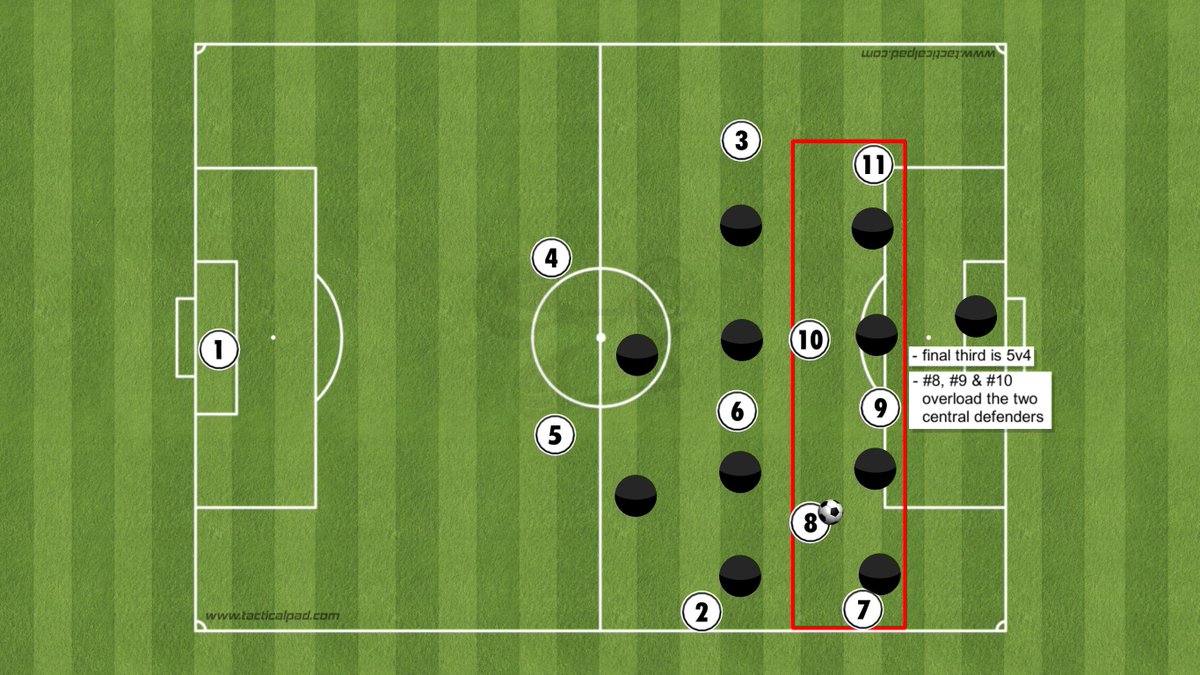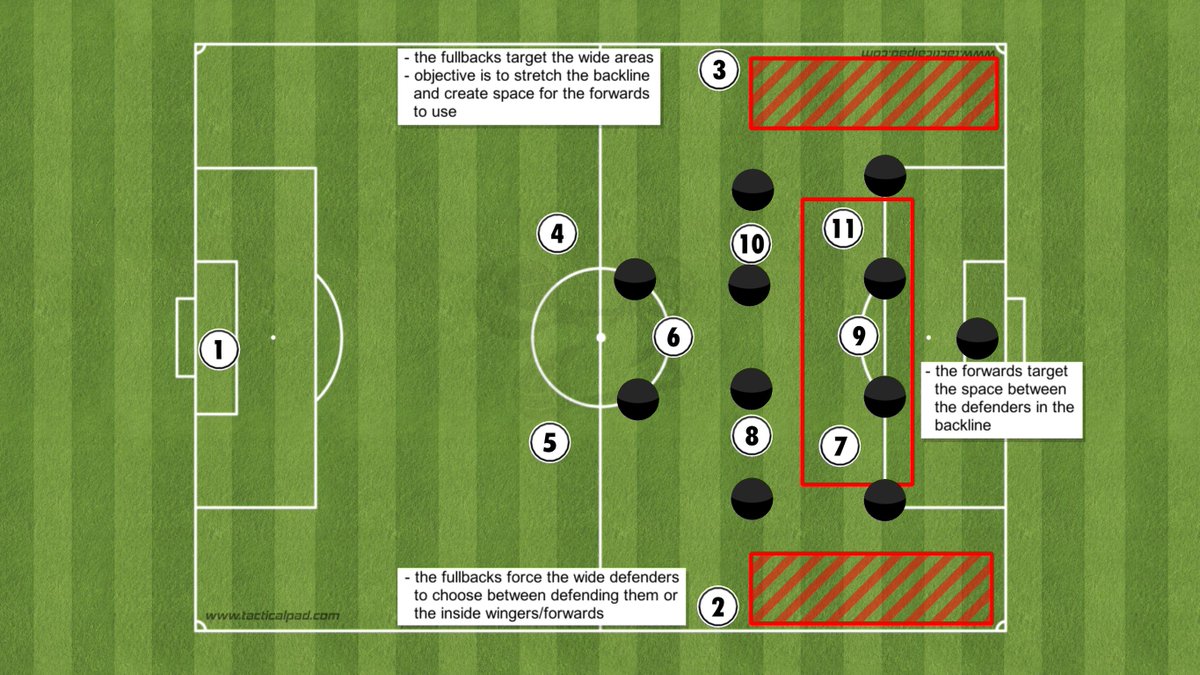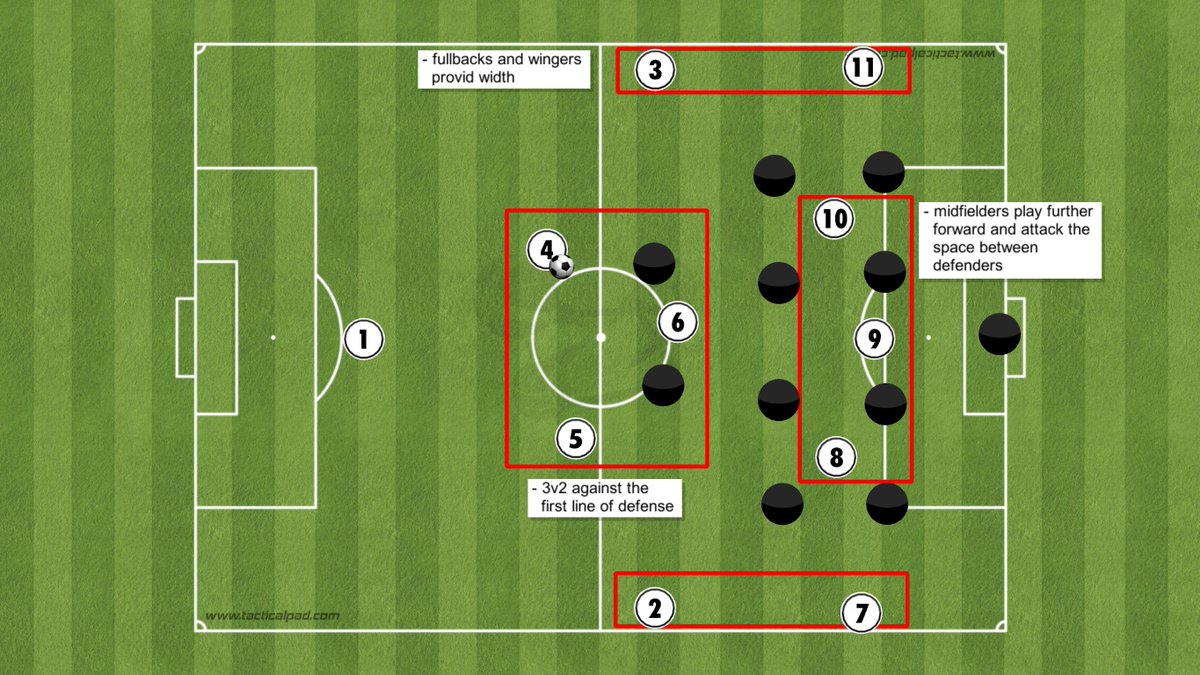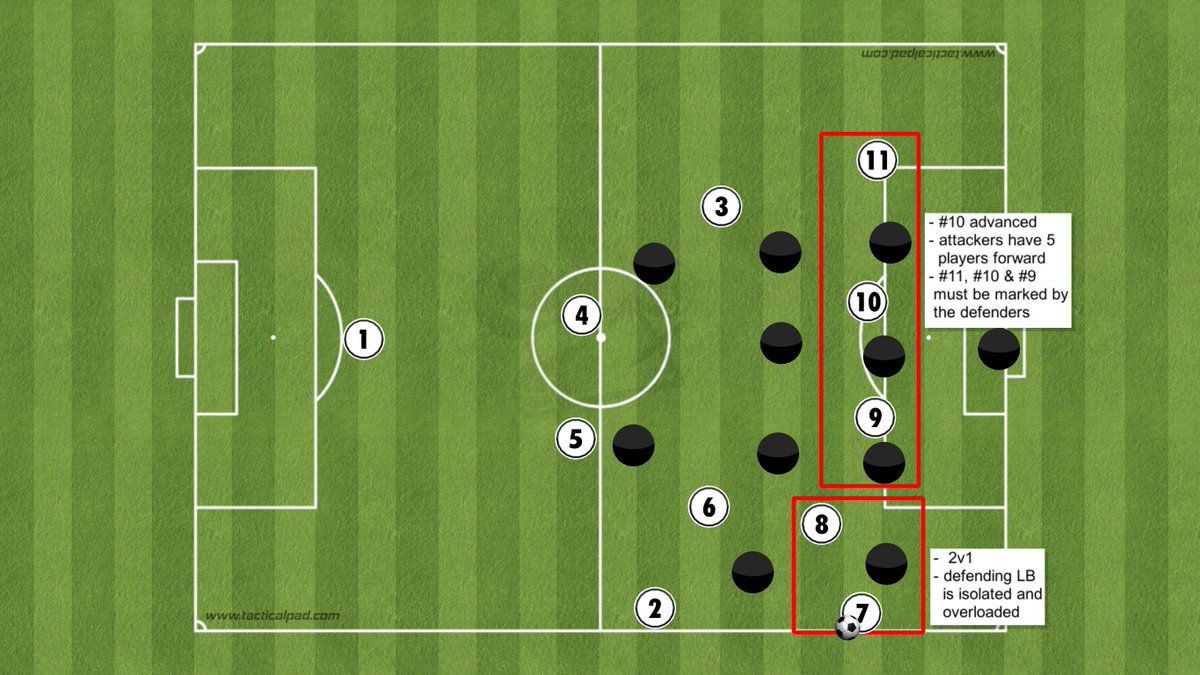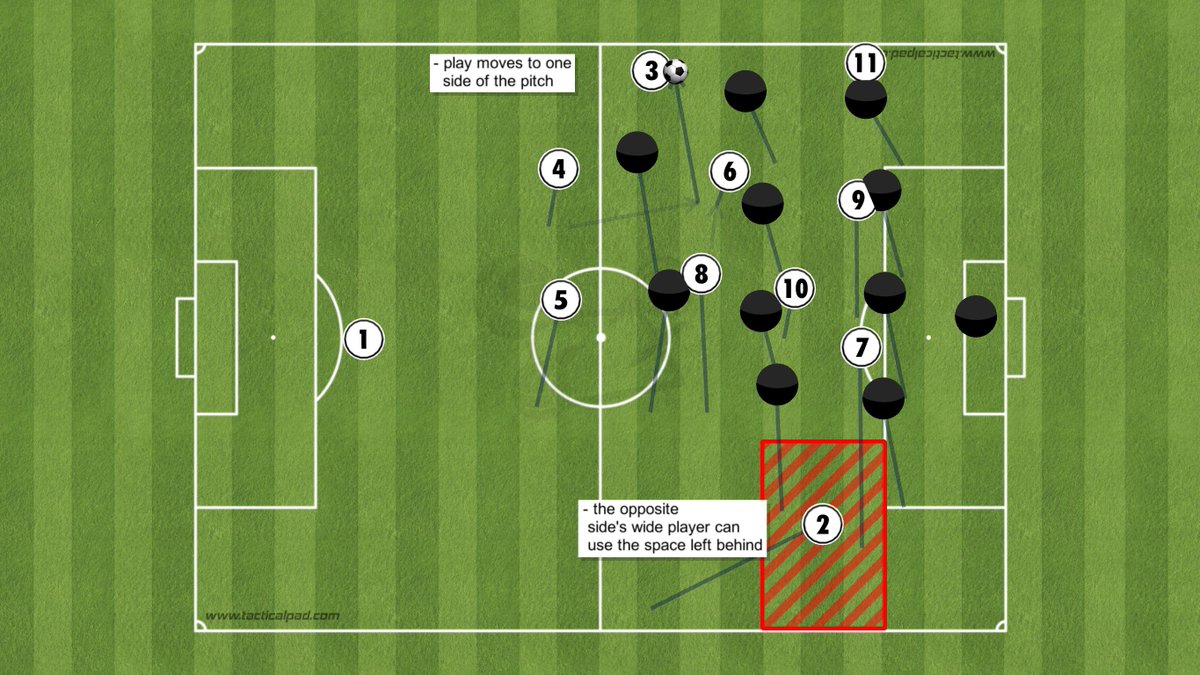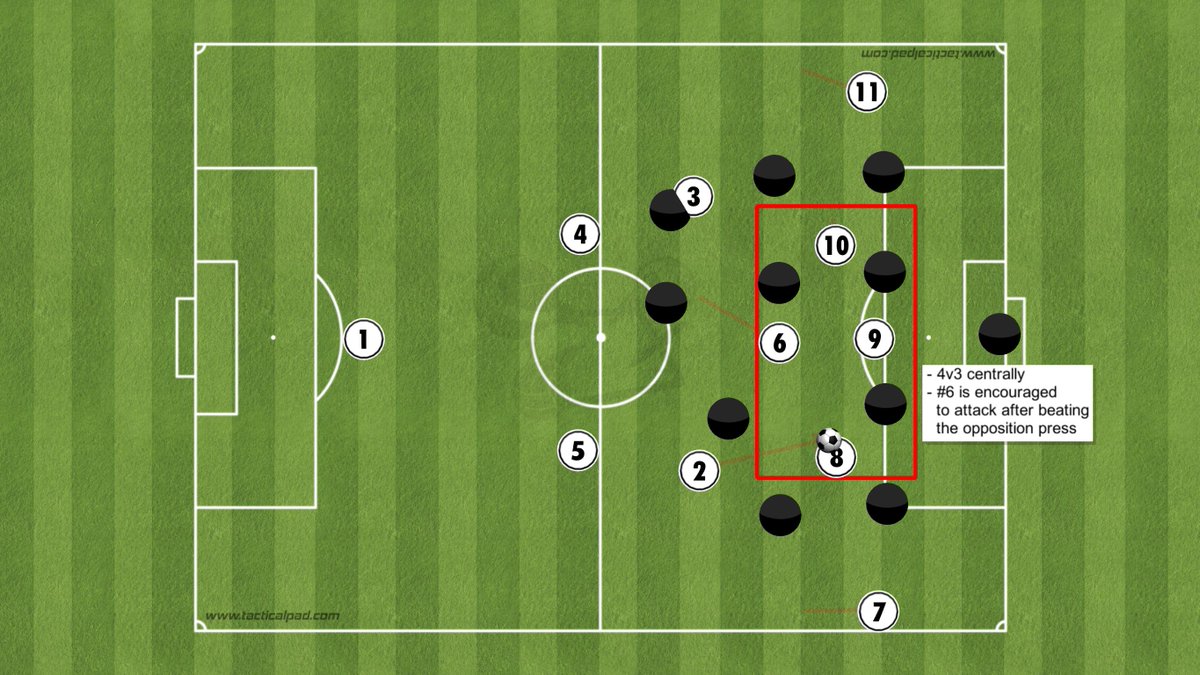PREFACE:
The defending team in this thread will be using a 4-4-2. I& #39;ve decided to use this shape because:
1) It& #39;s the one I, as a coach, have come up against most often when a team is defending.
2) It& #39;s the most common one I& #39;ve seen used in leagues around the world.
The defending team in this thread will be using a 4-4-2. I& #39;ve decided to use this shape because:
1) It& #39;s the one I, as a coach, have come up against most often when a team is defending.
2) It& #39;s the most common one I& #39;ve seen used in leagues around the world.
3) If I did every defensive shape we& #39;ve ever seen, this thread would be 100k words and no one would read it. I like to keep things short and sweet.
4) These are NOT the only ways to beat a low block, so if I& #39;ve missed some ideas, please share your thoughts!
4) These are NOT the only ways to beat a low block, so if I& #39;ve missed some ideas, please share your thoughts!
A low block is:
a defensive system where the players defend very deep in their own territory & restrict the space for opposition players to exploit. It& #39;s a more static form of defense, as there is not much movement compared to a team playing with high pressing intensity
a defensive system where the players defend very deep in their own territory & restrict the space for opposition players to exploit. It& #39;s a more static form of defense, as there is not much movement compared to a team playing with high pressing intensity
There are multiple similar definitions, but here is where I found the definition I used:
https://worldfootballindex.com/2020/07/low-block-park-the-bus-jose-mourinho-diego-simeone/#:~:text=The%20low%20block%20is%20a,playing%20with%20high%20pressing%20intensity.">https://worldfootballindex.com/2020/07/l...
https://worldfootballindex.com/2020/07/low-block-park-the-bus-jose-mourinho-diego-simeone/#:~:text=The%20low%20block%20is%20a,playing%20with%20high%20pressing%20intensity.">https://worldfootballindex.com/2020/07/l...
https://worldfootballindetwitter.com/2020/07/low-block-park-the-bus-jose-mourinho-diego-simeone/#:~:text=The%20low%20block%20is%20a,playing%20with%20high%20pressing%20intensity
Let& #39;s get started.
Here is how to beat a low block:
1) Create space for your players to use and attack it.
2) Create overloads (2v1s, 3v1s) in different areas of the pitch.
3) Isolate weaker players in the defending team.
Beating a defensive team is simple, but not easy.
Here is how to beat a low block:
1) Create space for your players to use and attack it.
2) Create overloads (2v1s, 3v1s) in different areas of the pitch.
3) Isolate weaker players in the defending team.
Beating a defensive team is simple, but not easy.
First, we should discuss how to beat the first line of defense. In this example, it& #39;s the two forward players. When using one deep midfielder ( #6) and two central defenders ( #4 & #5) it creates a 3v2. Our #8 and #10 are wider and can combine with the wide players.
Let& #39;s look at how a team playing with two deeper midfielders might beat the first line of defense. The double-pivot ( #6 & #8) are similar to the first example, but our #10 is central. This structure can favor teams that like to play down the middle.
Next, let& #39;s look at a team that plays with inverted-fullbacks. Our #8 and #10 are more advanced, the fullbacks offer the security of deeper midfielders, it creates a 5v2 against the first line of defense and there are many immediate and safe passing options.
Now that we know a few ways to beat the first line of defense, we can shift our focus to moving the ball into the final third. There are countless ways of doing it, but I& #39;ve decided to show 7 different examples.
Feel free to share what you think I may have missed!
Feel free to share what you think I may have missed!
Up first is every football hipster& #39;s favorite: the false #9. For the unfamiliar, it is essentially: a forward who drops from the forward line into midfield. We can get more complicated with definitions another time.
Here& #39;s a quick clip that shows how a false #9 may not even touch the ball but still cause confusion for the defending team.
This role is best used by players who like to make runs off the ball and create space for teammates to run into.
This role is best used by players who like to make runs off the ball and create space for teammates to run into.
This next example shows how a false #9 might operate in a team with wingers that tuck inside. Liverpool have used this idea regularly in the past few years.
By playing with wingers that tuck inside you can resemble a team that started the match with 2 center forwards, rather than just one.
Next is how a team with wide wingers might play. This is my personal favorite btw. I love a player who plays with chalk on their boots. Anyways, fullback and winger combine with the midfielder in the half-space.
As the ball moves from the middle third to the final third, our midfield players will advance. This can create an overload in the wide area (3v2) while also stretching the backline (5v4). This might force the defending team to drop a midfielder deeper, maybe into the backline.
Here is the ideas mentioned above in action. By forcing the low block to shift, space will be created, even if minimal.
The opposite of wide wingers is inverted wingers. I mentioned the use of them during the false #9 explanation, but now I& #39;ll go into more detail. Inverted wingers have right footers on the left and vice versa. Width is provided by fullbacks & a target can be the space between CB& #39;s
As the fullback moves into the final third, they are often closed down by the widest defender, midfielder, or both. This is done to win the ball back while shielding inside passing options. However, as a team closes down, space and an overload is created.
Here is a clip of how that might look. The backline is overloaded by the fullbacks, inverted wingers and #9, the half spaces are occupied by our #10 and #8, and we can move the ball to the central areas.
Next is how a team with very advanced midfielders might play. This is reminiscent of Manchester City& #39;s "Centurion" team. Wingers and fullbacks provide width while the midfielders play in similar roles to the inverted wingers I mentioned above.
As play moves into the final third, the winger and "widest" midfielder can combine to overload the defending fullback, while the opposite midfielder joins the forward line. İlkay Gündoğan has performed the latter role excellently for Manchester City this season.
Here& #39;s a clip showing how that might work. It does require the attacking team to be fluid and full of players who are comfortable moving in and out of different positions regularly.
Now I& #39;d like to talk about how a team might use their ability to move the ball to the opposite flank quickly to unsettle their opponent. If a defending team shifts easily and quickly, this might be a tactic to use. It can create more gaps as the defenders get tired.
I& #39;ve seen Juventus use this tactic often this season. With players like Chiesa, Cuadrado, Dybala and McKennie, these quick shifts in play have been the a main source of their attacks. It relies on having pacey wide players and midfielders who can move the ball quickly.
Having Cristiano Ronaldo who can finish most chances helps too, I guess.
Finally, I& #39;d like to talk about a tactic that has become more common in recent years: inverted fullbacks. They offer the defensive cover that deeper midfielders would, allow the midfielders to take up advanced positions while the wingers add width to stretch the backline.
As play moves to the final third, overloads are created in the wide areas and central areas in both the middle and final thirds. This clip shows how to punish a low block that has just one player close down the attackers.
Not every team can play with inverted fullbacks because not every team has fullbacks who are 1) capable of playing inside and 2) capable of being creative while playing inside. If it were easy, everyone would do this.
I& #39;m certain that there are more than just 7 ways to beat a low block. This doesn& #39;t mean that we& #39;ve solved football either. We have the ideas to beat a team that defends, but that doesn& #39;t mean that we can. These ideas just set the players up for success.
I should also mention that these ideas also come with their own set of cons. Counter-attacks exist. It isn& #39;t just "kick it long and pray" (although that is a tactic itself.) Teams looks at how their opponents attack so they know how to counter-attack once they& #39;ve won possession.
Finally, it is possible that one team might use all these ideas in the same match. Players, managers and coaches are always looking for ways to create chances. Rarely do teams attack in one way. However, the quality of their ability to attack in other ways is up for debate.
END OF THREAD:
I hope you enjoyed this thread. I love to talk football tactics & ideas. These threads are always a pleasure to make bc I can reference them when I coach. They& #39;re a great way for me & others to learn more about football! They also always lead to good discussion!
I hope you enjoyed this thread. I love to talk football tactics & ideas. These threads are always a pleasure to make bc I can reference them when I coach. They& #39;re a great way for me & others to learn more about football! They also always lead to good discussion!
If you& #39;ve made it this far, thanks! Your stamina is truly unmatched and I appreciate your interest in wanting to learn. If you have any additions you& #39;d make to this thread, please feel free to do so! There& #39;s plenty of ways to beat a low block and I& #39;d love to learn more.
I want to thank @RussellPope99 @SBunching @city_tactics @lambertsmarc @C_Carpenter14 @Zonal_Marking @slawekmorawski @_jasminebaba @EricLaurie for all the content they create & have created that has helped me learn so much about football. You & your work is invaluable. Thank you.
I& #39;d also like to share this with some coaches who are doing great things. @CoachDavidBaird @jackecoaching @coachingbadges & @BlaineMcKenna77. While we may not be managing Champions League teams, having a tactical understanding of football is crucial in player development.

 Read on Twitter
Read on Twitter